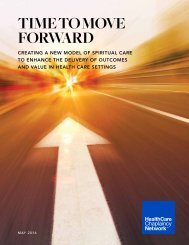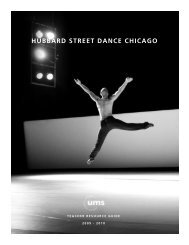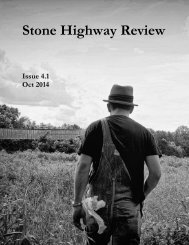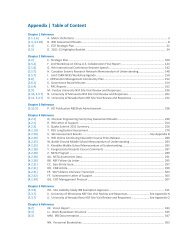ICAME Journal No. 34examples that happen to catch our notice into some location. 9 These examplesmay be bits of conversation that we have heard, whole advertisements or lettersor other texts that have caught our attention, or perhaps it is some text that weintend to use as an example for teaching some topic. Then, when we come tolook for data of some type for our analysis, we search our store of examples andwork with them. I compare this approach to the approach of a person who likesto sew, and collects all sorts of pieces of cloth just in case one might come inhandy. Such an approach to data gathering is something all linguists do, and isquite valuable. I think, for example of Otto Jespersen, who gathered thousandsof examples from an unspecified body of English literature. 10 We cannot replicateor test his work, because we do not know the exact sources he used, and hecertainly did not sample these sources exhaustively. However, the examples hecollected are all valid examples of language in use and he was able to use themeffectively as a basis for his landmark descriptions of English grammar. Howeverexamples gathered informally, as he did, may not represent the full range ofphenomena available, and they are very likely to misrepresent the frequencieswith which certain language features are encountered.An alternative approach to the gathering of data is to systematically gather arepresentative sample of some facet of the language, paying careful attention towhat the sample is intended to represent and also to the techniques used togather the sample. Two examples of careful samples are the old Brown and theLOB corpora which claim to be stratified random samples of written British andAmerican English.Let me follow Matthiessen (2006:107) in using the term archive to representthe informal collection of data which happen to be convenient, and corpus torefer to a more careful sampling of language. With this distinction in mind, <strong>Fries</strong>tried to gather corpora. While this was his goal, I suspect that most of the corporathat he used were compromises. 11 I have already mentioned that he wantedto examine spoken language, and yet he had no means to do so regularly untillate in his life. Thus, his 1925 study of shall and will was based on drama, whichhe considered an approximation of the spoken language. His study of the growthof the structural use of word order excluded poetry in the belief that, of writtenlanguage, poetry deviated most from the spoken language. His study comparingVulgar English with educated English used letters written to the War Departmentduring World War I because that was a convenient source of minimallyedited data produced with limited objectives by educated and uneducated writerswith known backgrounds. Only when we get to his study that was publishedas The structure of English do we find him using recorded material. But eventhat was a compromise in that, because of practical limitations, he had to limit102
Charles C. <strong>Fries</strong>, linguistics and corpus linguisticshimself to recording conversations on a single phone line. The result was thatthe data represented the language practices of only a few people. While I do notbelieve that fact seriously compromised his results, it does mean that these dataare not a true random sample of Spoken American English, nor even of theEnglish spoken in Ann Arbor at that time.2.7 The methodology used as one analyzes a corpus should beexhaustive and systematicOnce one has gathered a corpus, one may take one of several approaches to analyzingit. These range from (a) an ‘informal’ use in which one searches the corpusfor examples that suit one’s purposes and then reports those examples; (b) asystematic, exhaustive analysis of all the relevant examples in the data; and (c) asystematic and exhaustive counting of conflicting contrastive features of someaspect of the language. <strong>Fries</strong> used all three of these approaches, though heclearly preferred the third. The three sections of Table 2 classify <strong>Fries</strong>’s projectsaccording to the way he used his corpora (see Section 3.7 below).<strong>Fries</strong> took the first, informal and non-exhaustive approach to using corporaas part of his work on the Early Modern English dictionary. 12 This dictionarywas to be one of several period dictionaries which would supplement the OxfordEnglish dictionary (the OED). To begin with, <strong>Fries</strong> obtained the slips for EarlyModern English from the Oxford University Press. In addition, he supplementedthese slips with a reading program quite similar to the one used at the OxfordUniversity Press for the OED. The reading program for the OED did not attemptto be exhaustive. That is, readers were not asked to find every example of thewords they were searching for. Rather they were asked to focus on uses of thewords which were likely to be new uses, or late survivals, or of particular interestin some other way.<strong>Fries</strong> took the second, more systematic, approach to corpora in a secondaspect of his reading program for the Early Modern English dictionary and alsoin his work with The structure of English. He realized that, given the type ofreading program he inherited from the OED, he could not possibly tell the differencebetween what was a normal use of a word and what was unusual. Indeedthe OED slips would have represented primarily unusual – remarkable – uses ofthe words. Further, the OED slips would have typically illustrated uses that wereunambiguous. (I think of this as the ‘good example’ phenomenon. If you arelooking for a word used to express a particular meaning, you look for a clearexample that illustrates that usage with minimal ambiguity or room for dispute.)It was <strong>Fries</strong>’s contention that much of the development of the vocabulary movedfrom one meaning to another through instances that were ambiguous. As a result103
- Page 1 and 2: Charles C. Fries, linguistics and c
- Page 3 and 4: Charles C. Fries, linguistics and c
- Page 7 and 8: Charles C. Fries, linguistics and c
- Page 9 and 10: Charles C. Fries, linguistics and c
- Page 11 and 12: Charles C. Fries, linguistics and c
- Page 13: Charles C. Fries, linguistics and c
- Page 17 and 18: Charles C. Fries, linguistics and c
- Page 19 and 20: Charles C. Fries, linguistics and c
- Page 21 and 22: Charles C. Fries, linguistics and c
- Page 23 and 24: Charles C. Fries, linguistics and c
- Page 25 and 26: Charles C. Fries, linguistics and c
- Page 27 and 28: Charles C. Fries, linguistics and c
- Page 29 and 30: Charles C. Fries, linguistics and c
- Page 31: Charles C. Fries, linguistics and c








